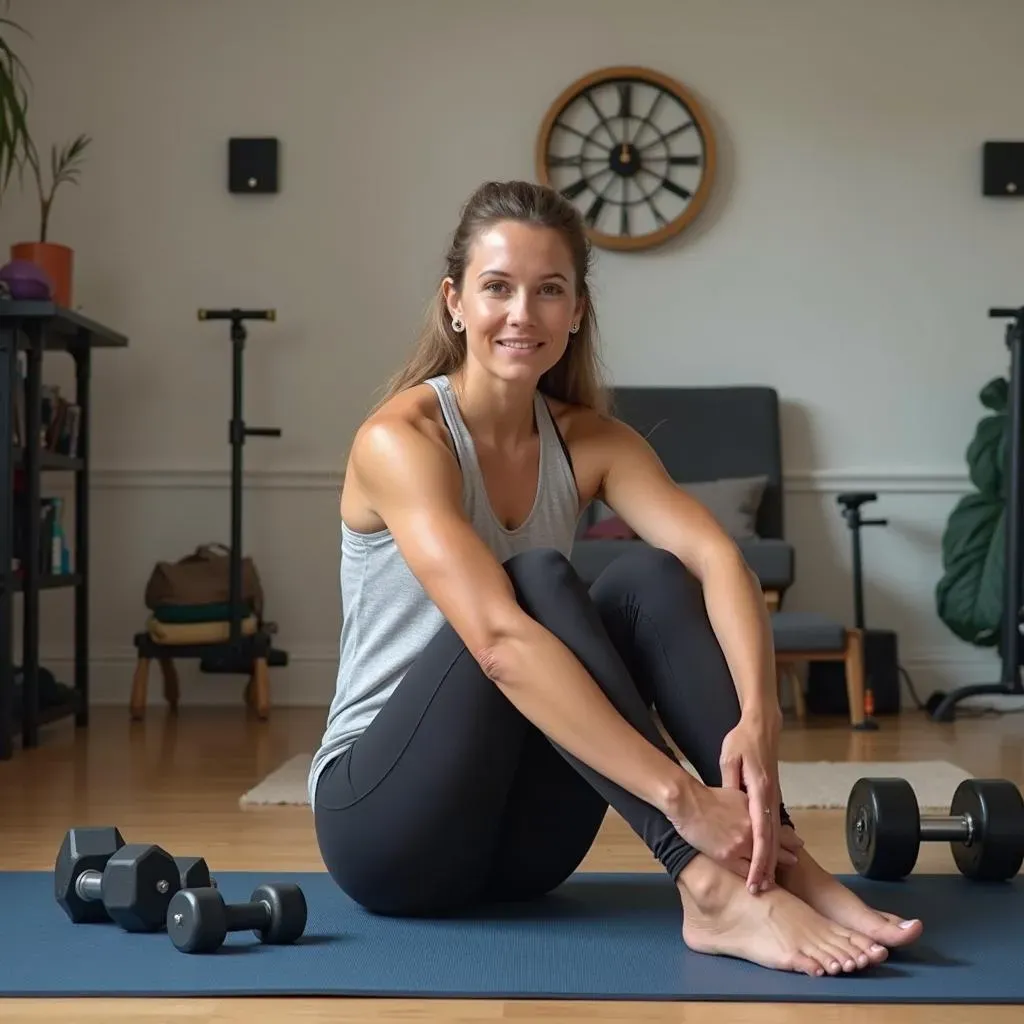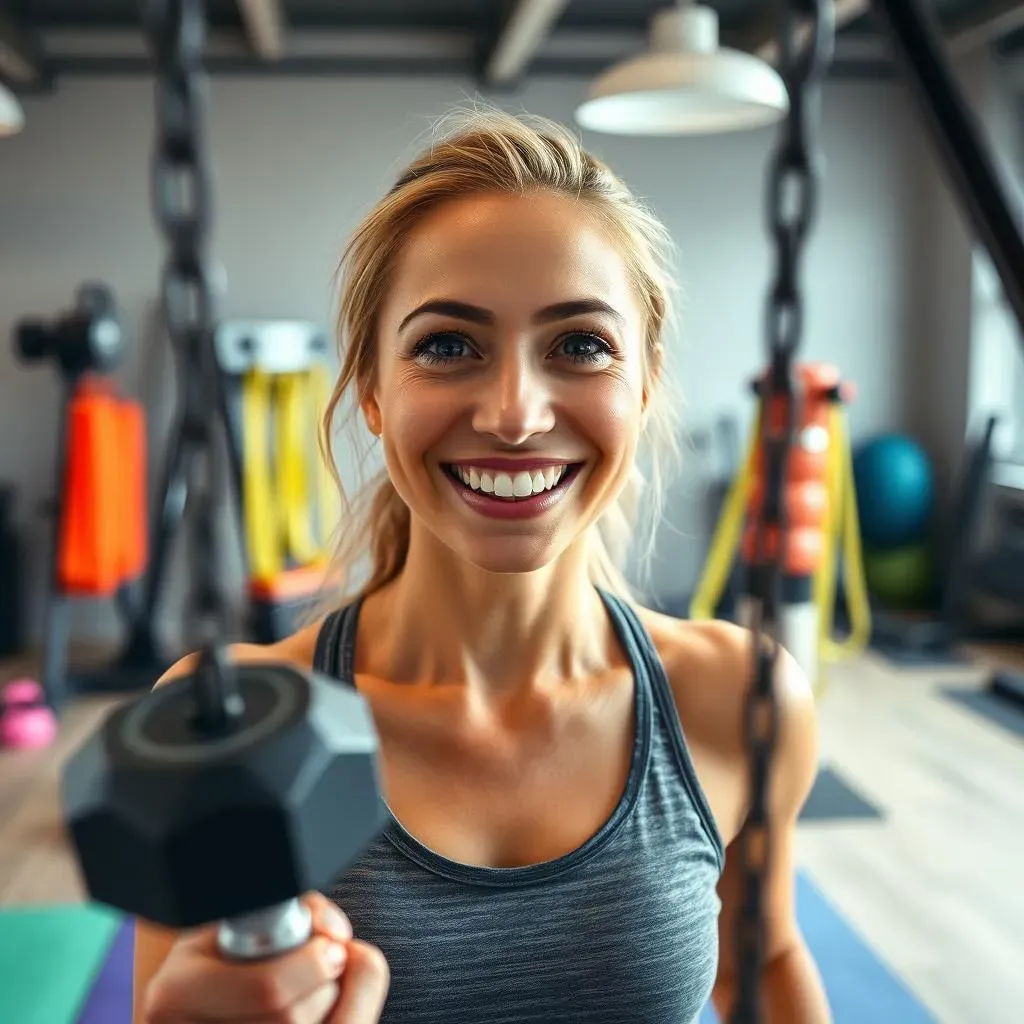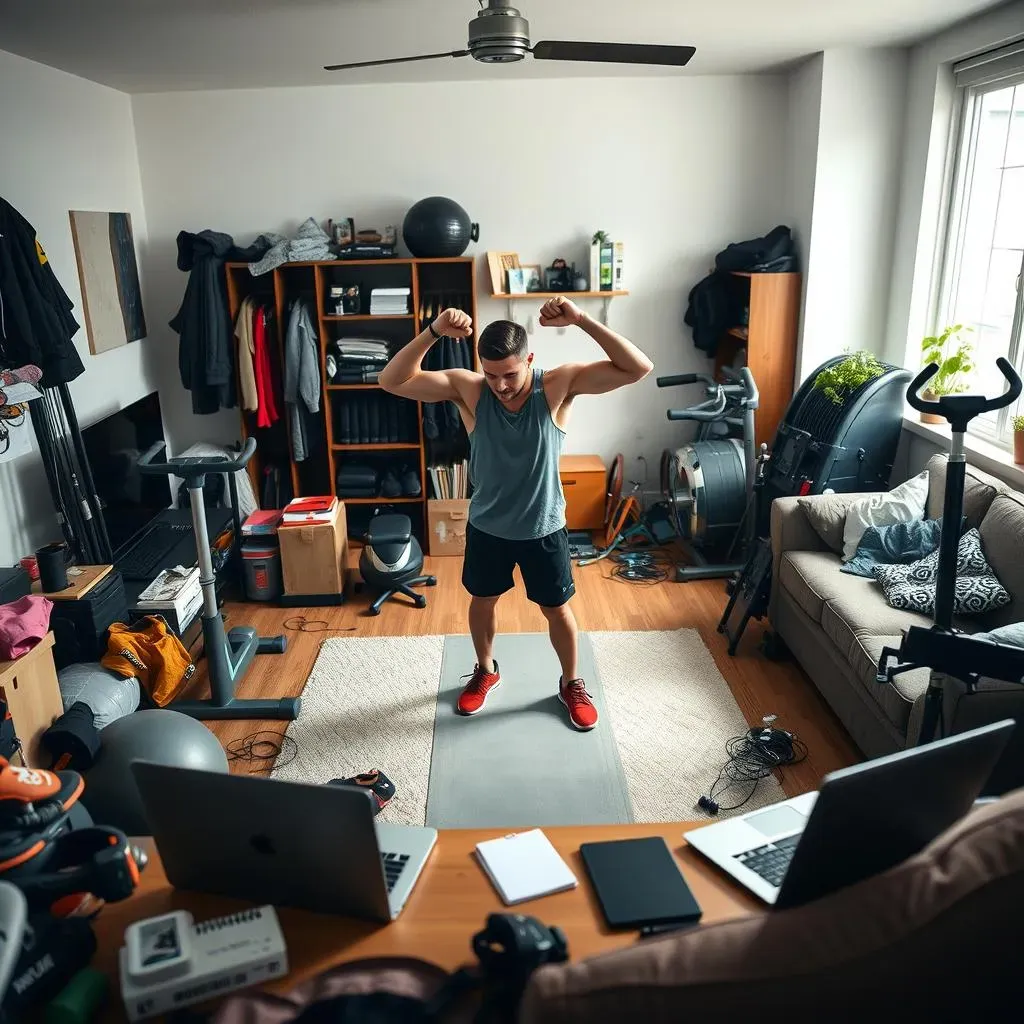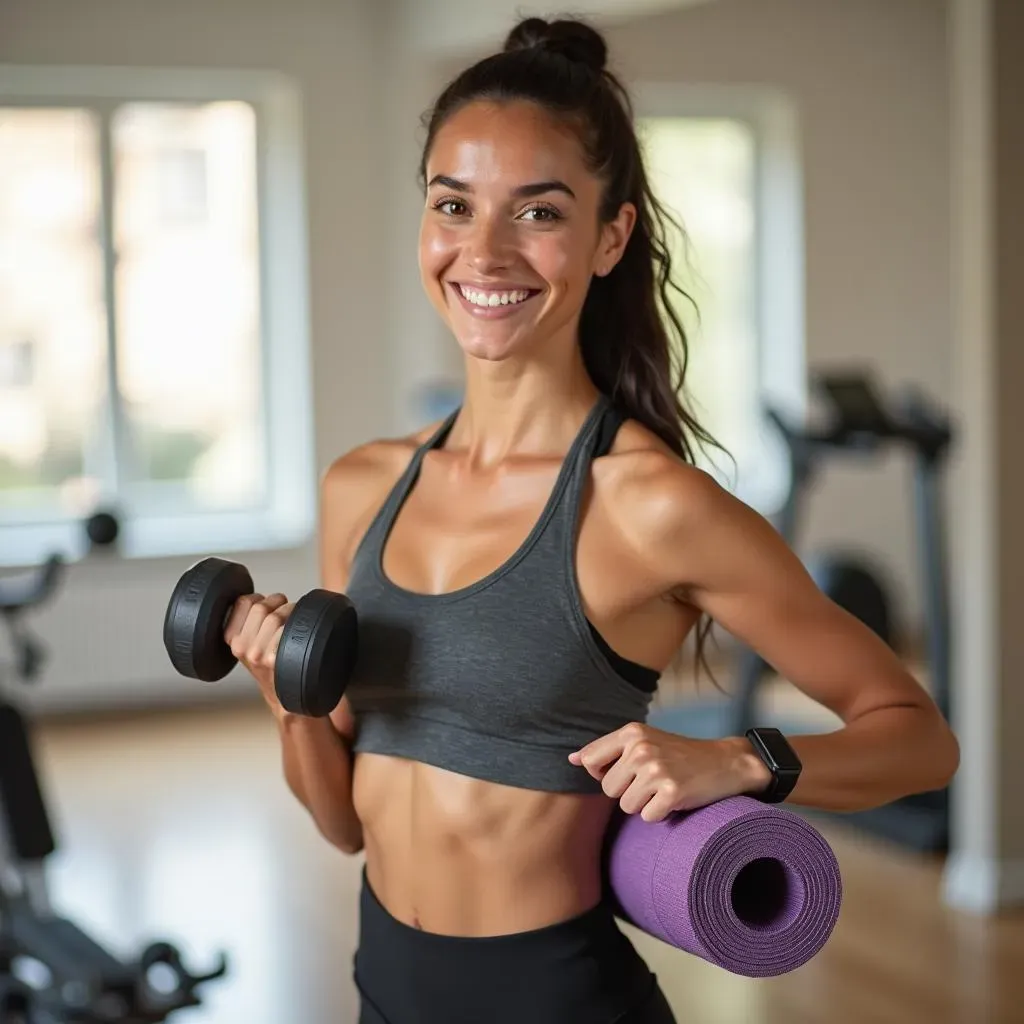Table of Contents
Thinking about turning that spare room into your personal fitness haven? You're not alone! Starting a home gym can feel like a huge step, especially if you're new to the whole fitness thing. It's easy to get lost in a sea of equipment, wondering what's actually worth your time and money. Don't worry; I've been there, staring blankly at rows of dumbbells, feeling totally overwhelmed. This guide is your shortcut through the confusion. We'll break down the best beginner home gym equipment, what to look for, and why it matters. We'll also cover the benefits of having your own setup and answer those nagging questions you've been afraid to ask. Forget the gym intimidation and the pricey memberships, let's get you set up with the right gear to start crushing your goals, right at home. Get ready to learn what works, what doesn't, and how to make your home gym a place you actually want to be.
Best Home Exercise Equipment for Beginners
Best Home Exercise Equipment for Beginners
Okay, so you're ready to dive into the world of home fitness. That's fantastic! But where do you even start with all the equipment choices? Let's keep it simple. For beginners, you don't need a room full of complicated machines. Start with the basics that give you the most bang for your buck. Think about functional movement - things that mimic how your body naturally moves. We’re talking about gear that helps you build strength, improve your cardio, and increase flexibility without requiring a PhD in exercise science. I'm a huge fan of keeping it minimal at first; you can always add more later once you figure out what you enjoy and what your body responds to.
Here's a quick rundown of some top picks for beginners:
- Dumbbells: Versatile for strength training, easy to store.
- Resistance Bands: Great for all fitness levels and super portable.
- Jump Rope: Cheap, effective cardio, and fun!
- Yoga Mat: Essential for stretching and floor work.
- Adjustable Bench: Useful for varied exercises, consider if you have space
How We Picked and Tested Beginner Home Gym Equipment
How We Picked and Tested Beginner Home Gym Equipment
Real Talk: No Fluff, Just Results
Alright, so how did we actually choose these pieces of equipment? It wasn't just pulling stuff off a shelf and saying "yeah, that looks good." I spent time researching and testing, and I made sure we focused on what's important for beginners. We looked at things like ease of use, how well it supports basic exercises, and of course, the price. Let's be real, no one wants to drop a fortune on stuff they might not even use. It’s about finding that sweet spot where quality meets affordability. I also read tons of reviews, both good and bad, and talked to other fitness folks to get their take. It was all about finding what's truly helpful for someone just starting out, not what's trendy or expensive.
We also considered space. Not everyone has a huge basement they can convert into a gym. So, portability and storage were key. Can you easily tuck it away when you’re done? Is it something you can take with you if you move? These were the questions we asked. The goal was to recommend gear that fits into real lives, not just a perfect gym scenario. We wanted to make sure what we suggested was practical and versatile, not just another piece of equipment gathering dust in the corner.
The Testing Gauntlet
Testing wasn't just a one-time thing either. I used these items myself, doing a variety of exercises, and also got feedback from friends who are new to working out. I wanted to see how they felt, how easy they were to use, and if they actually helped with workouts. We looked at things like how comfortable the dumbbells were to hold, if the resistance bands were durable, and if the yoga mat was thick enough for comfort. It was about making sure the equipment wasn't just functional, but also pleasant to use. Nobody wants to dread their workout because their gear is uncomfortable or awkward.
We also put the equipment through a bit of a durability test. We wanted to see how well they held up with regular use. Are the resistance bands going to snap after a few weeks? Are the dumbbells going to fall apart? We made sure that the items we recommend can withstand the wear and tear of regular workouts. After all, the point of buying home gym equipment is to have something that lasts, and not something you have to replace every few months.
Criteria | Description |
|---|---|
Ease of Use | Equipment should be simple to understand and use, no complex setups required. |
Durability | Must withstand regular use and last for a reasonable time. |
Versatility | Can be used for multiple exercises and fitness goals. |
Portability | Easy to store and move around, suitable for small spaces. |
Affordability | Good quality without breaking the bank. |
Benefits of Exercise Equipment for Beginners
Benefits of Exercise Equipment for Beginners
Why Bother with Equipment?
Okay, so you might be thinking, "Why do I even need equipment? Can't I just, like, run around?" Sure, you can, and that's great too! But the right equipment can actually make your workouts more effective and a whole lot more fun. Think of it like this: you could try to build a house with just your hands, or you could use tools to make the job easier and faster. Exercise equipment is like those tools for your fitness journey. It helps you target specific muscle groups, get a better range of motion, and add resistance to your workouts. And let's be honest, sometimes it's just more motivating to have something to work with. It's like having a workout buddy that doesn't cancel on you last minute.
For beginners, especially, having some basic equipment can be a game-changer. It can help you learn proper form, which is super important for preventing injuries. It also makes it easier to gradually increase the intensity of your workouts as you get stronger. Plus, it adds variety to your routine, which keeps things interesting and prevents boredom. It's all about setting yourself up for success and making exercise something you look forward to, instead of something you dread. Remember, consistency is key, and the right equipment can help you stay on track.
More Than Just Muscles
Beyond building biceps, exercise equipment can help you in so many other ways. It's not just about looking good; it’s about feeling good. Regular exercise, with or without equipment, has been shown to boost your mood, reduce stress, and even improve your sleep. When you work out, your body releases endorphins, which are natural mood boosters. It’s like a little happy pill, but without the side effects. And who doesn't want to sleep better? Quality sleep is essential for everything from focus to overall health. Using equipment can help you create a more structured workout, which can lead to better results and a more consistent routine.
Think about it like this: using a resistance band isn’t just about getting stronger arms. It's also about improving your balance and coordination, which can help you in everyday activities. Lifting a dumbbell isn't just about building muscle; it's also about improving your bone density, which is super important as you get older. So, while you're working on your fitness, you’re also taking care of your body in the long run. It's like a two-for-one deal: you get to feel good now and set yourself up for a healthier future. It’s about creating habits that benefit you for years to come.
Benefit | Description |
|---|---|
Improved Strength | Equipment provides resistance for effective muscle building. |
Better Cardio | Tools like jump ropes boost heart health and endurance. |
Increased Flexibility | Yoga mats and bands improve range of motion. |
Mood Enhancement | Exercise releases endorphins for a better mood. |
Better Sleep | Regular physical activity can improve sleep quality. |
Buying Guide: What to Look for in Exercise Equipment for Beginners
Buying Guide: What to Look for in Exercise Equipment for Beginners
Okay, so you're ready to actually buy some gear, awesome! But hold your horses, before you click "add to cart" on everything that looks shiny, let's talk about what to consider. It's easy to get caught up in the hype and end up with a bunch of stuff you never use. The key is to be smart about your purchases. Think about your personal fitness goals, your space, and your budget. It’s about making a plan that fits your life, not forcing your life to fit the equipment. Don't feel like you need to buy everything at once; start with a few essentials and add to your collection as you progress.
First up, think about your space. If you're living in a small apartment, you're not going to want a massive treadmill taking up half your living room. Look for compact, portable options that can be easily stored. Next, consider your budget. You don’t need to spend a ton of money to get a good workout. There are plenty of affordable options available that will get the job done. Don't forget to read reviews and compare prices before making a purchase. The goal is to find equipment that's both effective and within your budget. And lastly, think about what you actually enjoy doing. If you hate running, a treadmill is probably not the best purchase. Choose equipment that aligns with your interests and the types of exercises you enjoy. This will make it way easier to stick with your workout routine.
Factor | Consideration |
|---|---|
Space | Is the equipment compact and easy to store? |
Budget | Is it affordable and good value for money? |
Goals | Does it align with your fitness goals? |
Enjoyment | Do you actually enjoy using the equipment? |
Reviews | What are other users saying about the product? |
FAQs About Exercise Equipment for Beginners
FAQs About Exercise Equipment for Beginners
What's the best equipment for a complete beginner?
Okay, let's tackle the big question everyone asks: "What do I actually need to get started?" If you're totally new to this, don't feel like you need to buy everything at once. I'd suggest starting with a few key pieces that are versatile and easy to use. Think of it as building a foundation. A good set of dumbbells is a fantastic starting point, because you can use them for so many different exercises. Resistance bands are another excellent choice because they are lightweight, portable, and great for all fitness levels. A yoga mat is essential for floor work and stretching. And, if you're looking to add some cardio into the mix, a jump rope is a cheap and effective way to get your heart rate up. These basics will give you a solid foundation for a full-body workout without overwhelming you with too much gear.
Remember, the goal is to start simple and build from there. Don't feel pressured to buy expensive, fancy equipment you don't understand how to use. It’s more effective to start with a few basic items and learn how to use them properly. Once you’ve established a routine and understand your body's needs, you can gradually add more equipment as needed. The key is to focus on consistency and proper form, not just having the most expensive gear. And don't worry, you'll find what works best for you as you go. Everyone's journey is different, so embrace the process and don't be afraid to experiment!
How do I make sure I'm using equipment safely?
Safety first, always! Before you start throwing weights around, it’s super important to understand how to use each piece of equipment correctly. If you're unsure about the proper form for a certain exercise, don't be shy about looking it up online or consulting a professional. There are tons of great resources available, from YouTube videos to online fitness guides. Starting with lighter weights is a smart idea too, it's better to master the technique before increasing the resistance. And, don't forget to warm up before each workout and cool down afterward. This helps prevent injuries and prepares your body for the exercise ahead. A good warm-up could be some light cardio and dynamic stretches, while a cool-down could include static stretches, holding each stretch for 30 seconds.
Also, pay attention to your body. If you're feeling pain, stop! It's better to take a break and rest than to push through and risk an injury. Listen to what your body is telling you; it's usually pretty good at giving you signals when something is off. And don't be afraid to ask for help. If you're not sure about something, it's always better to get clarification than to risk getting hurt. You can also consider using online workout apps or joining a fitness community for guidance and support. Remember, fitness is a journey, not a race, so take your time, learn as you go, and prioritize safety above all else. It's about creating a sustainable routine that you can stick with for years to come.
FAQ | Answer |
|---|---|
Best equipment for beginners? | Dumbbells, resistance bands, yoga mat, jump rope. |
How to use equipment safely? | Start light, learn proper form, warm up, cool down, listen to your body. |
Wrapping Up Your Home Gym Journey
So, there you have it, your guide to setting up a killer home gym without breaking the bank or your spirit. Remember, the best beginner home gym equipment is the stuff you'll actually use. Don't get caught up in the hype; focus on what fits your body, your space, and your goals. Start small, stay consistent, and don't be afraid to adjust as you go. Building a home gym is a marathon, not a sprint. You've got this, and I'm genuinely excited for you to start your fitness journey, right in the comfort of your own home. Now, go get those gains!